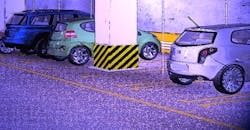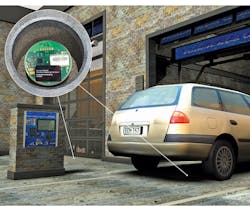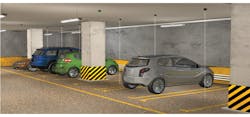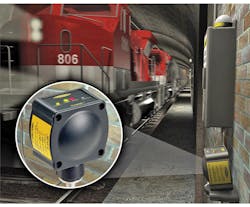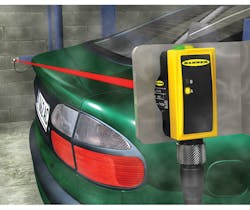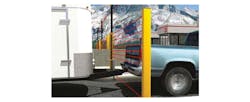What are the Differences Between Vehicle-Detection Technologies?
Download this article in PDF format.
The ability to reliably detect vehicles offers significant advantages for asset management, resource allocation, site safety, and traffic control. Identifying the right technology for your vehicle-detection application can be challenging, and many factors must considered, including task, size of target, sensing range, sensor mounting, and whether the application is primarily indoor or outdoor.
For each of the five technologies discussed here, we describe advantages, important considerations, and typical applications. Please note that many of these technologies can be used to solve the same application, and in some cases, it may be beneficial to combine two sensing methods to achieve the required level of precision. This article offers general guidelines for educational purposes and is not exhaustive.
Wireless Magnetometer
Sensing range: Depends on the size of target
Size of target: All targets, but smaller vehicles such as motorcycles may be more difficult to detect
Mounting: Can be installed above grade or below grade (typically one inch below grade)
Indoor/outdoor: Both
Magnetometers can be either wired or wireless, but for the purposes of this article, we will focus on wireless magnetometers, which offer important advantages to the end user. A magnetometer works by using a passive sensing technology to detect large ferrous objects (for example, a truck, automobile, or rail car) by measuring the change in the ambient magnetic field. When a vehicle alters that magnetic field, the sensor detects those changes. As with other sensors, the range of the magnetometer will depend on the target.
Wireless magnetometers from Banner also feature an advanced algorithm that detects fluctuations and adjusts accordingly.
Advantages of Wireless Magnetometers
A wireless magnetometer provides a cost-effective and convenient alternative to other sensing technologies. It requires no wiring or external control box, but achieves an accurate and repeatable response. Furthermore, wireless magnetometers are much less invasive, less expensive, and easier to commission quickly compared to inductive loops. This is because wireless-magnetometer units are small, self-contained, and don’t require extensive work under the concrete.
Some wireless sensors can be installed above grade or below grade. Installation time should be minimal to reduce downtime. In addition, a wireless magnetometer that is encapsulated in rugged epoxy will prevent moisture penetration and ensure long-term reliability, even in adverse weather conditions. Furthermore, a truly wireless magnetometer will not only offer wireless communication via radio, but also be completely self-contained, including the battery. The long life of the battery ensures continuous performance for years at a time.
Considerations
In order to reliably detect when the magnetic field is disrupted, a magnetometer must first be calibrated for typical ambient magnetic conditions. Therefore, a vehicle must not be present during sensor calibration. Another consideration when installing a magnetometer is that if the sensor moves out of alignment over time, it may not function properly. Because of this, a magnetometer must be rigidly fixed at the time of installation to ensure reliable operation over time. Finally, in cold climates that experience large amounts of snow, it is often necessary to install the magnetometer below grade to avoid damage from snowplows.
Example Applications
- Car wash: A magnetometer can be used to reliably detect vehicles at the entrance queue of a car wash. It is able to provide collision avoidance and serve as an entry-door trigger.
- Overhead door: A magnetometer can be used to trigger the opening of high-traffic internal overhead doors. Mounted in the floor, it reliably detects forklifts or trucks as they approach the doors.
- Drive-through: A magnetometer is able to reliably detect vehicles at drive-through systems or other drive-up kiosks. Upon detection of a vehicle, it can trigger personnel that a vehicle is present, as well as initiate a timing system.
- Loading dock: A magnetometer can reliably detect the presence of a vehicle backing into a dock, triggering a light in the building to notify the dock attendant that a vehicle is in position for loading and unloading.
Wireless Ultrasonic Sensor
Sensing range: Up to 4 meters
Size of target: All targets
Mounting: Overhead
Indoor/outdoor: Indoor
A wireless ultrasonic sensor is often an ideal solution for indoor or covered parking applications. Using sound waves to detect objects, an ultrasonic sensor can be mounted directly onto the ceiling of a parking garage to identify the presence of a vehicle in the parking space below.
Advantages of Wireless Ultrasonic Sensors
A wireless ultrasonic sensor with an integrated battery reduces the cost of installation by eliminating the need to run wires and conduit. In addition, target color and/or reflectivity don’t affect ultrasonic sensors, which can operate reliably in high-glare environments.
Considerations
One important consideration for a wireless ultrasonic sensor is mounting, since there must be a space to mount the sensor overhead. Another consideration is foot traffic. In parking garages, pedestrians may walk through a parking space, falsely triggering the sensor. To compensate for this, a time-delay filter can be used to differentiate between a person momentarily walking through and a parked vehicle occupying the space. However, this time delay could also impact accuracy if the filter doesn’t have enough time to clear between one vehicle pulling out of a spot and another vehicle pulling in.
In addition, ultrasonic sensors are not as suitable as other sensors for ambient weather conditions such as high winds, which may deflect or disturb the path of the ultrasonic wave. Furthermore, since temperature fluctuation affects the speed of sound waves, an ultrasonic sensor may not function reliably when exposed to extreme changes in temperature. If you do plan to use an ultrasonic sensor in an application that may be exposed to varying temperatures, consider a model with built-in temperature-compensation capability.
Special note: Changes in air temperature affect the speed of sound, which in turn affects the total time for the echo measured by the sensor. An increase in air temperature shifts both sensing window limits closer to the sensor. Conversely, a decrease in air temperature shifts both limits farther away from the sensor. This shift is approximately 3.5% of the limit distance for a 20°C change in temperature. To deal with those fluctuations, Banner Engineering developed ultrasonic sensors that are temperature-compensated to reduce sensor errors from temperature by about 90%.
Banner’s DX80 wireless ultrasonic sensor is able to use retro-wave technology to detect the presence of vehicles. This means the sensor is taught a distinct point within its sensing range (e.g., the ground) and will detect any object regardless of shape, size, or reflective angle that crosses between the sensor face and the taught point.
Example Applications
- Covered parking: A wireless ultrasonic sensor can be used to detect vehicles in covered-parking applications; for example, to detect whether space is available in a covered-parking ramp.
Radar Sensor
Sensing range: Up to 40 meters
Size of target: Large, predictable targets
Mounting: Minimum of 6 feet from target
Indoor/outdoor: Outdoor
Radar sensors use frequency-modulated continuous-wave (FMCW) radar to reliably detect moving or stationary targets, including cars, trains, trucks, and cargo, in extreme weather conditions.
Advantages of Radar Sensors
Radar sensors are ideal for long-range outdoor applications. Unlike photoelectric or ultrasonic sensors, radar sensors are not affected by conditions such as wind, rain, fog, light, humidity, and air temperature. Thus, they offer accurate detection in outdoor environments. Many sensors can also be configured to detect objects up to a specified distance, ignoring objects beyond the set point, resulting in higher accuracy. Furthermore, while inductive and capacitive sensors can detect only moving targets, radar sensors are able to detect both stationary and in-motion vehicles.
For train-detection applications, a radar sensor offers many advantages, including flexible mounting. Because a radar sensor does not need to be mounted on the train track, installation and maintenance are safer and easier compared to other sensing technologies. In addition, since radar sensors are not mounted on the tracks, the devices have lower risk of damage due to high impact.
A radar sensor is able to reliably detect train cars in a tunnel.
Considerations
It can be challenging for radar sensors to detect smaller targets as well as vehicles with little separation between them (such as in bumper-to-bumper traffic). For this reason, a very common application of radar sensors is to detect train cars, which are both large and predictable.
Example Applications
- Rail: Trains create difficult environments for mechanical and technical equipment to operate properly. Passing trains create excess wind, dirt, debris, and potential for impact. A radar sensor can reliably detect the presence of trains even in harsh conditions.
- Loading dock: For an efficient flow of products in and out of a truck, it is important that operators are immediately notified of a truck’s arrival. A radar sensor can reliably detect vehicle presence at a loading dock even in extreme weather conditions.
- Electric-car charging station: To prevent non-permitted vehicles from parking at electric-car charging stations, a radar sensor be used to can identify unauthorized vehicles and alert officers to their presence.
Optical Sensor (Infrared)
Sensing range: Up to 200 meters
Size of target: 5 millimeters or greater
Mounting: Requires mounting for both emitter and receiver
Indoor/outdoor: Indoor
Compared to other technologies, optical sensors are not used as frequently for vehicle detection, but they can be a good option for some applications. An opposed-mode optical sensor uses the interruption of a light beam between an emitter and receiver to detect objects. For example, the presence of a vehicle passing between the emitter and receiver breaks the beam of light. This technology can be used to detect, for instance, whether a vehicle has completely exited a car wash.
Advantages of Optical Sensors
Optical sensors offer reliable long-range sensing for indoor vehicle-detection applications. Some optical sensors, like the QS30 photoelectric sensor from Banner, utilize infrared light, which can burn through mist and steam. As a result, these sensors become reliable options for environments with high water temperatures, such as car-wash bays.
Infrared optical sensors can detect a vehicle exiting a car wash.
Considerations
An opposed-mode optical sensor requires mounting for both an emitter and receiver unit. Furthermore, weather conditions often affect optical sensors more than other technologies, so they are usually better suited for indoor applications. Many photoelectric sensors can be blinded by sunlight, so for any outdoor applications, look for a sensor with sunlight immunity. And for applications that will expose the sensor to high-pressure, high-temperature water, look for a sensor with IP69K-rated housing.
Example Applications
- Car wash: High-pressure water, variations in temperature, mist and steam, and the constant cycling of machine movement can make vehicle detection challenging. A rugged optical sensor with an IP69K-rated housing—as well as infrared light to burn through mist and steam—can reliably detect vehicles in this environment.
- Over-height protection: Tolling applications often require a sensor to detect whether a vehicle is too tall. A rugged optical sensor with sunlight immunity can provide reliable detection in extreme conditions, and look through mist or fog.
Measuring Light Grid
Sensing range: 500 millimeters to 2 meters
Size of target: All sizes
Mounting: Requires mounting for both emitter and receiver
Indoor/outdoor: Outdoor
Measuring light screens are often used for vehicle detection to start and stop a transaction (e.g., paying a toll at a toll booth). A sender and receiver are installed on either side of a toll lane, stretching an array of light beams across the lane. When a vehicle enters the detection area, data from each beam can be used to determine vehicle class and the number of axles with a high level of accuracy.
Like the MINI-ARRAY and EZ-ARRAY from Banner, measuring light grids have the ability to detect vehicles and tow bars at a toll booth.
Advantages
Toll-booth applications are becoming more and more automated to eliminate human error. It is important to get reliable data when a vehicle enters the toll station to define the correct category that is directly linked to the toll charge. The main challenge is that a wide variety of vehicles can come through the station: motorcycles, cars with or without trailers, trucks, etc.
Measuring light grids are composed of an array with multiple, synchronized emitter/receiver pairs at defined distances. They can be used to sense the profile of a vehicle, detect vehicle separation, and sense even the smallest parts like tow bars. A measuring light grid provides fast profiling of moving vehicles, accurately detecting vehicles regardless of their speed.
Considerations
In tolling applications, a light grid with robust housing is a must to protect the array from damage in case of collision. In addition, for climates with cold winters, installing a light grid in a heated enclosure allows the light grid to operate reliably even in variable weather conditions.
Example Applications
- Toll booth: Measuring arrays can be used when a vehicle is entering the toll station to define the correct category for the toll charge.
Conclusion
It is important to note that since no technology is 100% foolproof, applications that require the highest possible accuracy should consider implementing redundant technology. For example, a parking application might utilize both a radar sensor and a magnetometer to detect vehicles in order to assess appropriate parking fees. Using two sensor technologies simultaneously can help reduce risk of error in case of failure to one of the sensing methods. We recommend discussing your specific application needs with a professional.
